This is a continuation of a series of posts on the Nikon D850. You should be able to find all the posts about that camera in the Category List on the right sidebar, below the Articles widget. There’s a drop-down menu there that you can use to get to all the posts in this series; just look for “D850”. This is equally a post about the Sony a7RIII, and is also tagged as such.
In the two posts immediately before this one, I reported on the autofocus performance of the Sony a7RIII with the Sony Zeiss 55 mm f/1.8 (Zony 55) and the Nikon D850 with the Nikon 58 mm f/1.4 lens. I used the spot modes of the cameras, and AF-S and AF-C. Both these cameras have a face detection feature, and I suspect that they use more PDAF sensors (and, in the case of the a7RIII, a larger CDAF area) when they’re in that mode. I wondered if there would be a difference in accuracy and repeatability with face detection turned on. Both cameras were in continuous shutter mode, but I only shot one image at a time.
Since, in both cameras, the face detection is from a flat image projection (unlike the Apple iPhone X), I figured that a picture of a face could substitute for a real face, offering something that a) would not move, and b) had a single, well-defined focal plane, solving two problems associated with using an actual face. I knew this would work because I had noticed the a7RIII occasionally would detect faces in photographs even when there were real people in the shot. I taped a photograph to the LensAlign focusing plate. Here’s how the D850 sat it.
Here are the Nikon results using AF-C:
I’ve plotted the three Adobe RGB color channels. The graph presents displacement of the image projected on the sensor from the desired green-channel focal plane. Negative numbers indicate front-focusing. The image-plane shift is in micrometers (um). The blue focus locations are separated from the red and green ones because of the longitudinal chromatic aberration (LoCA) of the lens. The dots indicate the results for each of the ten exposures at each f-stop. I’ve made lines indicating the average (aka mean or mu) of the sample set bolder and added thin lines above and below the means that are one standard deviation (sigma) away from it.
Looking at the green channel, you can see that with the compromise AF Adjust setting of +5, The camera front-focuses wide open, and back focuses At f/stops narrower than f/2.8. That is exactly what happened in yesterday’s post with AF-C and the user-controllable spot. Unfortunately, AF-S back-focused under the same conditions. The other thing to notice is how much tighter the spreads at each aperture are. Apparently, face detection is more repeatable than spot autofocus. Who knew?
By adjusting the AF bias, we can make the camera focus properly wide open at a cost of making the narrow-aperture accuracy even worse:
Here are the circles of confusion implied by the amount of misfocusing in the above two graphs:
The pixel spacing in the D850 is about 4.3 micrometers. So no matter what you do with the AF adjustment setting you’re going to see CoC diameters of many pixels if you try to use the whole range of apertures with one setting.
Now we’ll look at the Sony in AF-C mode.
I apologize. I didn’t collect samples for f/2.5 and f/2.8. It is apparent that the variability that we’ve observed in the a7RIII in AF-C is not improved by using face detection. The variability also appears to be greater as the lens is stopped down (but, as you’ll see, depth of field (DOF) will ameliorate that), and worst at f/6.3 and narrower.
Here are the CoCs:
When DOF is taken into account, the errors in the green channel don’t get worse as you stop down. In fact, the mean-plus-sigma to mean-minus-sigma spread stays within about a two-pixel blur diameter. The is far better than the D850. The most important factor here is that the a7RIII is focusing stopped down to taking aperture and thus compensating for the focus shift in the lens. The D850 is focusing wide open.
Turning to AF-S:
In AF-S, the D850 still front-focuses wide open, but less so than in AF-C mode. It takes less compensationto fix that:
The CoCs in both cases:
For the a7RIII in AF-S:
There is little variation within sample sets, and The accuracy is good wide open, but there is no compensation for focus shift.
Looking at the COCs implied by the above graph:
Again we see green channel CoCs diameters within two pixel pitches. This is the same excellent performance we ended up with in AF-C mode, but we got there by a different path. Before the camera compensated for focus shift and had more variability, now it has less variation, but uncompensated focus shift.
And once more, the a7RIII is more accurate than the D850. Things might be different in a lens with little focus shift.
The D850 doesn’t have eye detection, but the a7RIII does. I turned it on in AF-C mode. I had to make an enlarged crop of the target to get it to find the eye.
It’s interesting that the eye-AF system is so consistent. In the original photograph that I used for the target, which was made with an a7RIII using eye-AF, the system picked the subject’s left eye (photographer’s right). It wasn’t the eye that I wanted it to pick. In the captures used to create the data you see below, it always picked the same eye, even though there is so little facial context. Here are the focus errors:
Actually better than with face detection.
The CoCs:
This is great performance.
I couldn’t test eye-AF with AF-C, because there’s no way to invoke that without touching the camera.
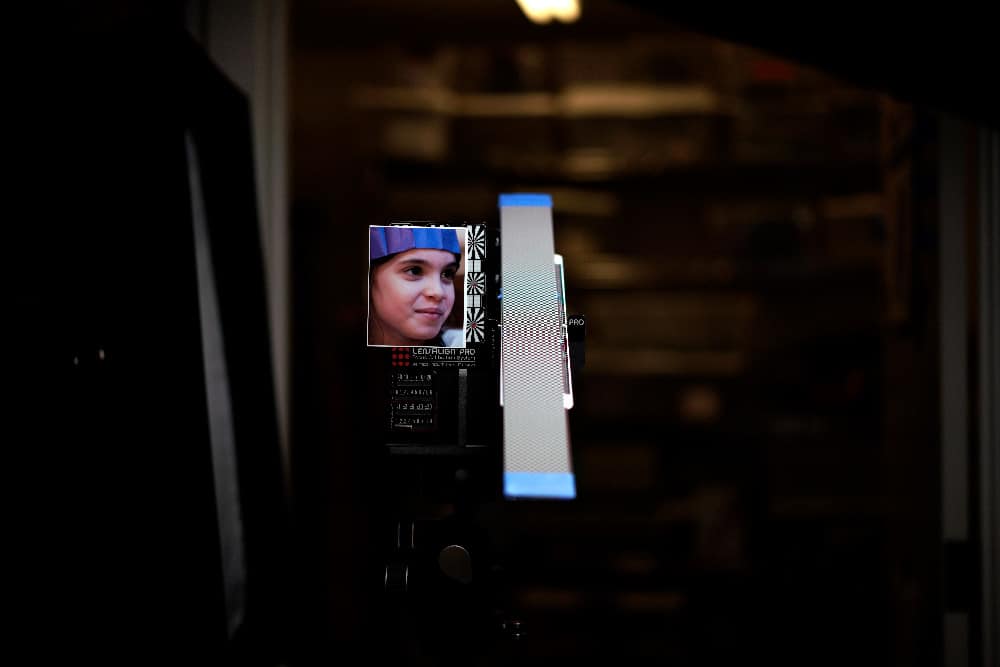
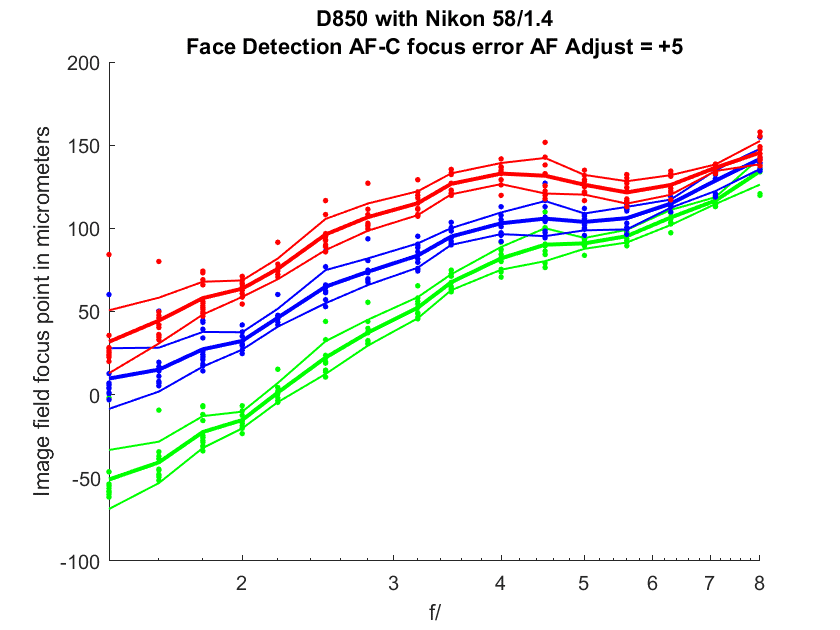
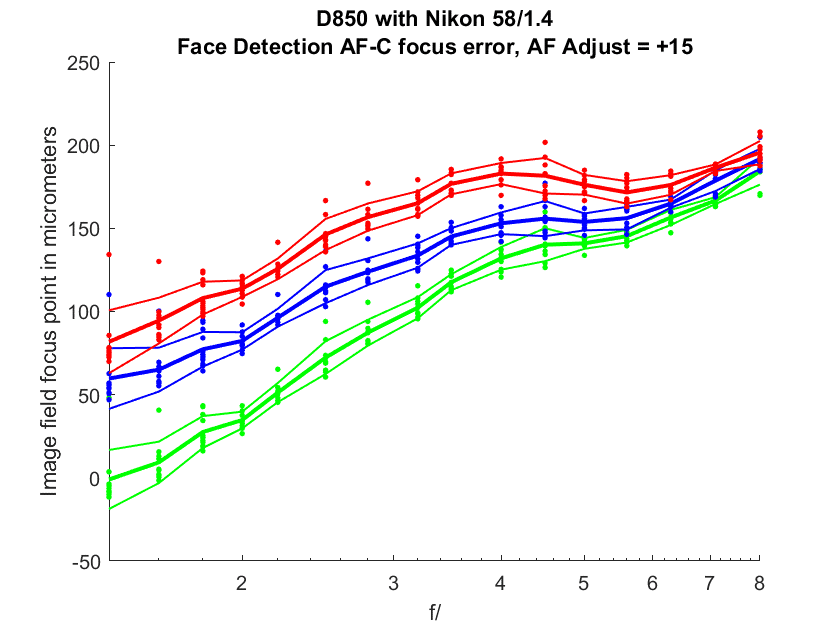

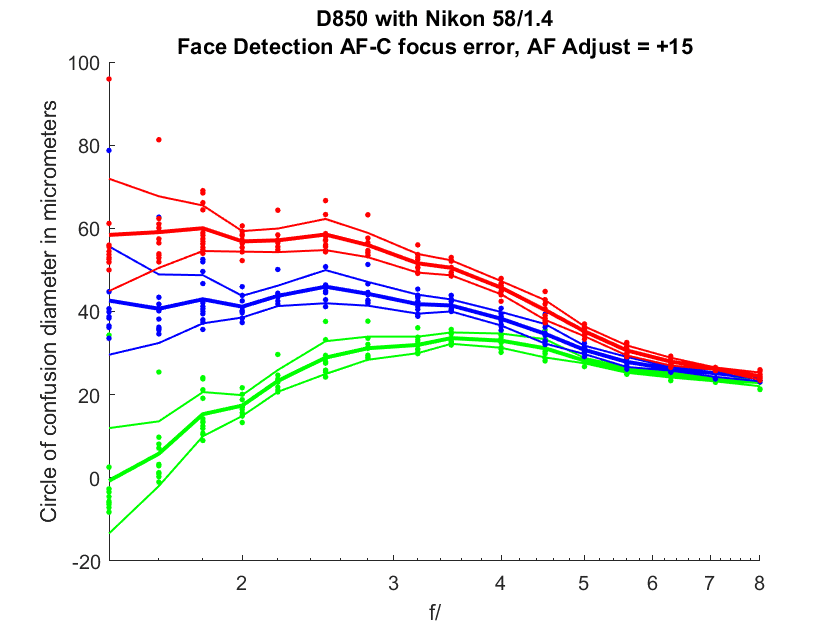
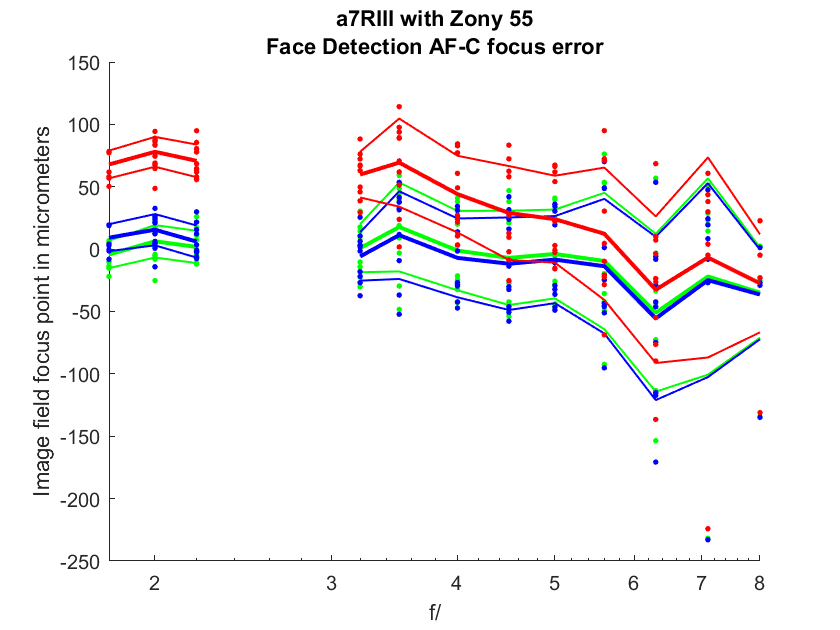
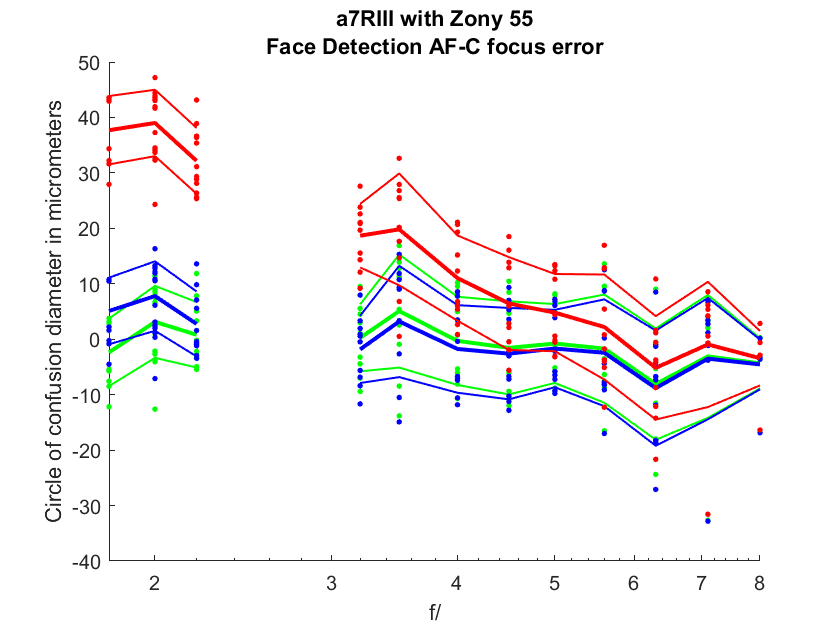
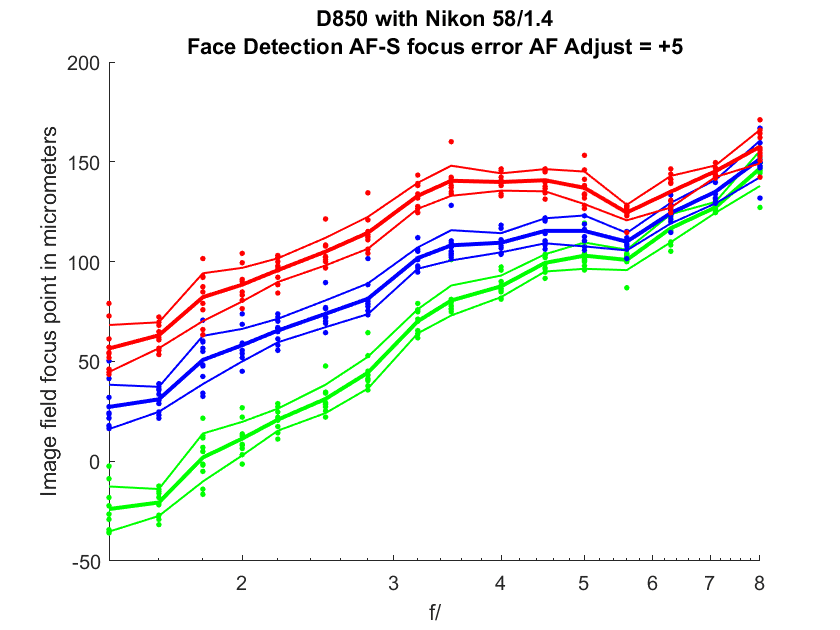
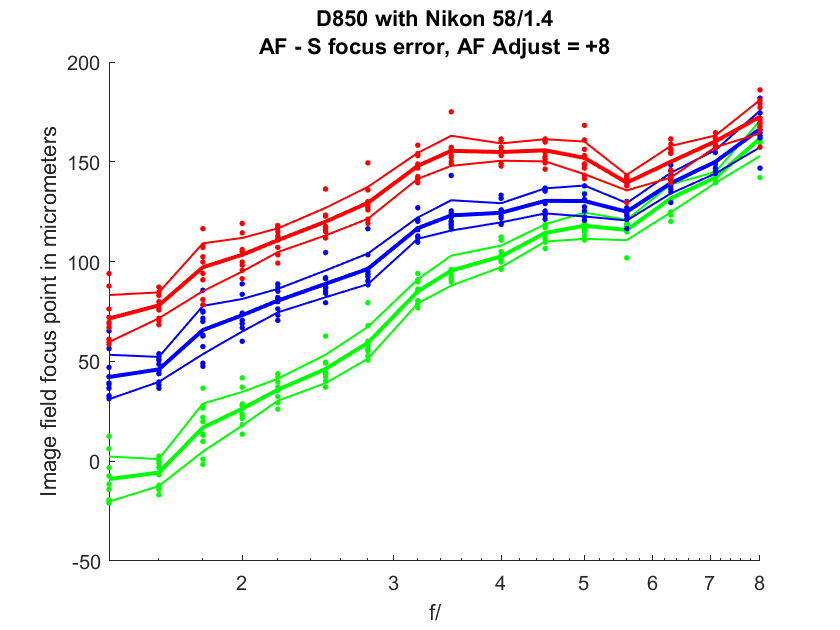
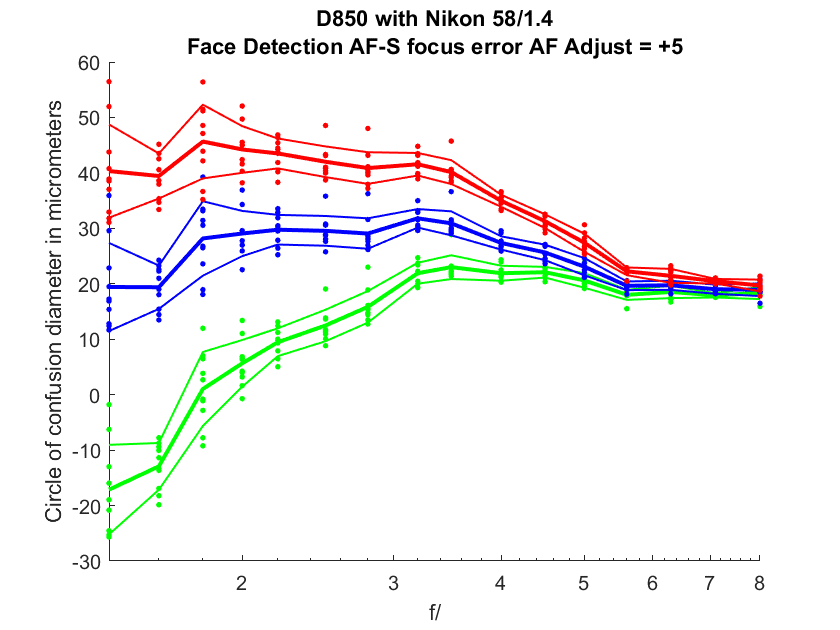
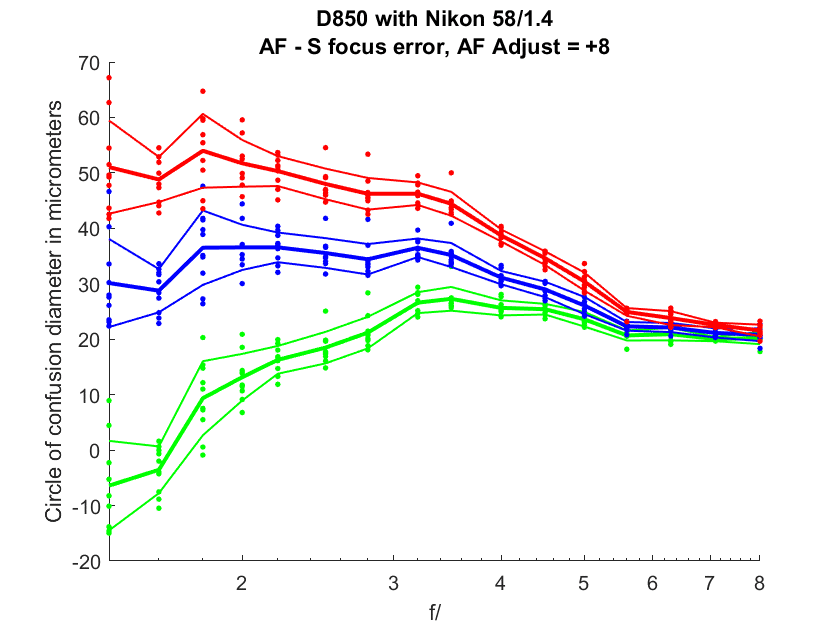
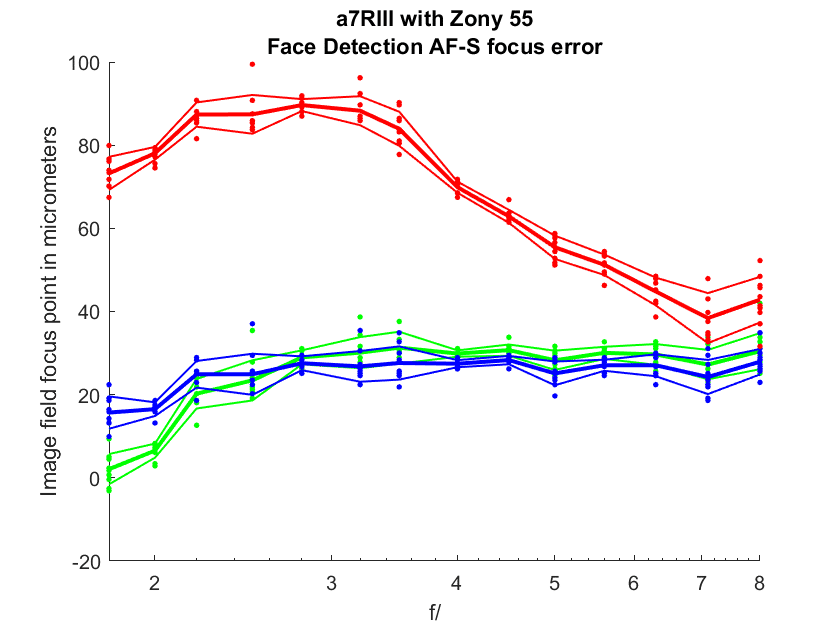

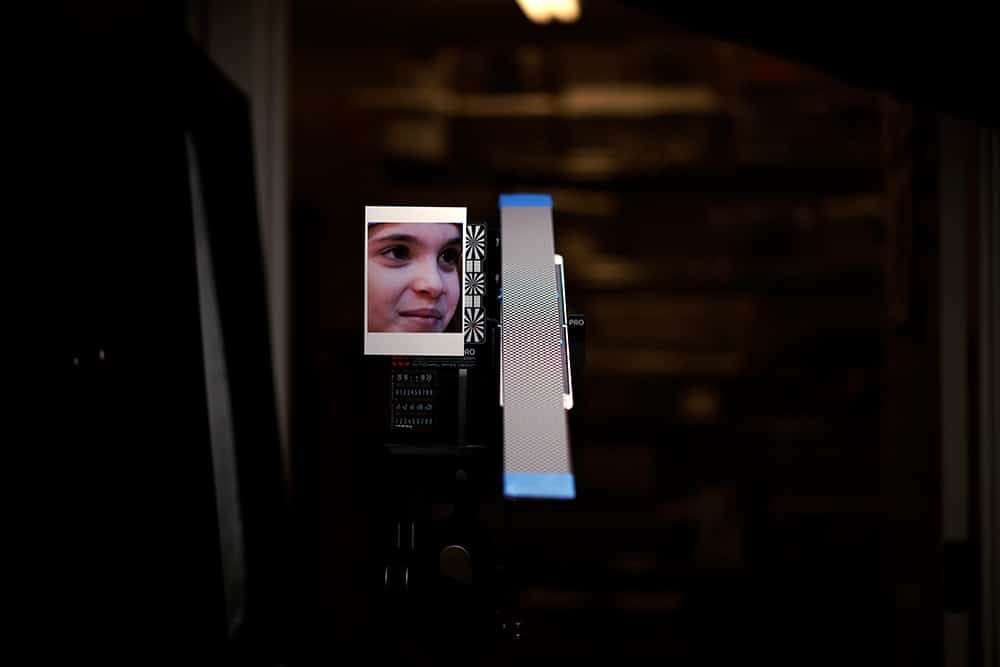
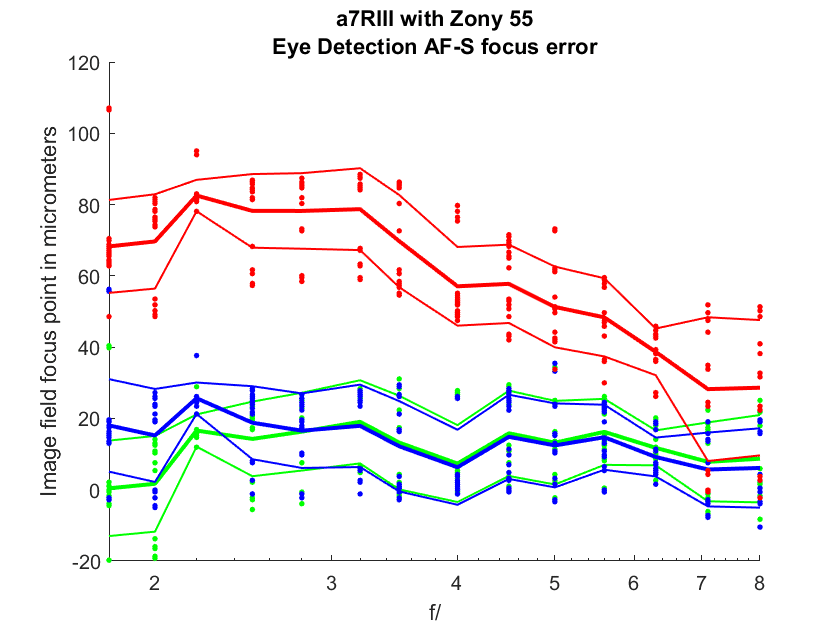
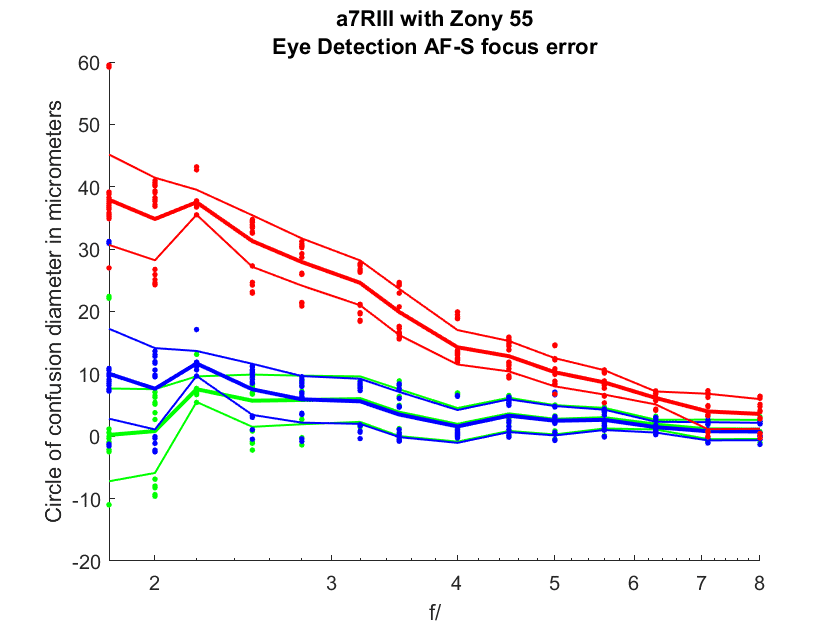
Arthur says
Jim,
Any thoughts on turning off the auto axis for the Y axis ?
It would more readily demonstrate the differences between the two sets of data.
Thanks,
JimK says
It would make differences between the graphs more apparent at a glance, but obscure differences within the graphs that get squished so that the comparison graph doesn’t clip. I hope that most readers are sufficiently quantitatively sophisticated to make the mental corrections.
Arthur says
I am getting the sense that you normally presented to other engineers and not to C-level when you were working.
The genius of Taleb and Hawking is that they knew how to present to the masses.
Last night, I said to my wife, that Sally Yates should be the next president.
My wife said, “she’s too smart and too smug. American’s resent that type of person. “
JimK says
Actually, for most of my career, I was ensconced in what would today be called the C-suite. Maybe that’s the problem. Or maybe there is no problem.
Anyhow, I think the thrust of your remarks is to encourage me to delineate the differences between the D850 and the a7RIII more clearly. I’ll see what I can do about that.
Grant Hodgeon says
Jim,
Coming from a Z-List hobbyist EE and someone who’s ‘technical’ to an extent in this world of Art vs Science — I’d agree that a more editorial context to the conclusion would help cement a lot of the ideas and exploration you’ve been doing. It’s typically in the laymen conclusion that the baron land of confusion fills with colour and clarity, and all of a sudden it’s pieced together with the glue of analogy… or something 🙂
Thanks for the intensely humbling and enjoyable musings that you post, Jim — no criticism here except in that I only wish I knew more, sooner 🙂
G
Livio Spallone says
Hi Jim
Great work as ever but I really do not understand the rationale of these last tests.
We know that D850 doesn’t correct the focus shift (or not enought) so testing a lens that shows a large focus shift can only stress the fact that these lenses can only be focus tuned and then USED within a limited range of f stops, the increasing dof being not enough to balance the large focus shift.
All the other data are a consequence of this problem.
The only real lesson here is : If you want critical focus using D850 Pdaf all the lenses that exibit a large focus shift are a big NO-NO ( or you have to limit the use to a couple of fstops).
JimK says
There are those who think that the D850 does correct for focus shift. There are those who think that the a7RIII corrects for focus shift in AF-S mode. I admit to being one of those a month ago. The other thing to get out of this is an appreciation for the variation in various modes, and that face detection in the D850 is a way to reduce that. Another thing, if you happen to have a 58 f/1.4, is to get an idea of what might be the possible compromise AF strategies. There are also many people who believe that D850 and a7RIII autofocus is “tack sharp” (often their words) all the time. They might learn something from this analysis.
Livio says
I bet that if you fine tune that lens at f3.5 and test it only within f3.5 – 8 the data will show around 1 pixel CoC and a low sigma : a ” tack sharp only if” parameter .
My very best regards
Livio
JimK says
Pretty close:
http://blog.kasson.com/the-last-word/more-d850-58-1-4-vs-a7riii-55-1-8-af-w-face-eye-detection/
Tero says
One can test Eye AF + AF-C in A7RIII by clamping down the Eye AF button (I tested both C1 and C4 and clamped them with a small 6 inch ratchet bar clamp) and using wired remote. Also, if you still have the A9 it would be quite interesting if it’s AF-C is more consistent vs. A7RIII as the A9 supposedly much more advanced focus system with faster sample rate etc. One would think faster sampling should improve consistency.